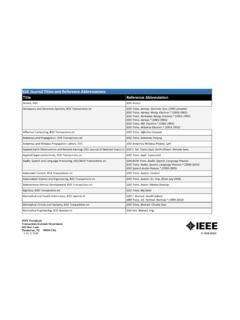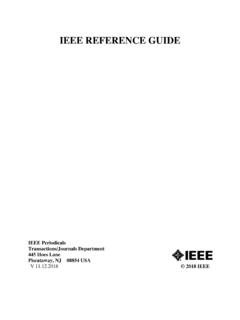Transcription of IEEE EDITORIAL STYLE MANUAL - ieeeauthorcenter.ieee.org
1 ieee EDITORIAL STYLE MANUAL . FOR AUTHORS. ieee Periodicals transactions /Journals Department 445 Hoes Lane Piscataway, NJ 08854 USA. V 2018 ieee . ieee EDITORIAL STYLE MANUAL FOR AUTHORS. 2. Table of Contents I. INTRODUCTION .. 3. A. Purpose of 3. B. Definition of a transactions and Explanation of the Review Process .. 3. C. ieee transactions Editing Philosophy .. 3. II. WRITING PRINCIPLES .. 3. A. Writing Parts of an Article .. 4. Title .. 4. Byline and Membership Citation .. 4. ieee Membership Grades .. 4. ieee Open Access Publishing Agreement (OAPA) .. 5. First Footnotes .. 6. B. The Body of the Article .. 9. Abstract .. 9. Index Terms .. 9. Note to Practitioners .. 9. Nomenclature .. 9. Text Section 10. Introduction .. 11. Text Equations .. 11. Appendix .. 11. Acknowledgment .. 11. References .. 11. Text Citation of Figures and Tables .. 12. Biographies .. 13. 14. C. Other 15. Footnotes .. 15. Lists in Text .. 15. Dedication Line(s).
2 16. Note Added in 16. D. Other Types of Papers .. 16. Editorials .. 16. Brief Papers .. 17. Short Papers, Correspondence, and 17. Comments and Replies .. 17. Corrections/Errata .. 17. Book Reviews .. 18. Obituaries/In Memoriam .. 18. E. Writing STYLE for transactions .. 18. Acronyms .. 18. Spelling .. 18. 19. Plurals .. 19. Hyphenation Rules .. 19. The En, Em, or Two-Em Dash .. 19. Grammar .. 19. Contractions .. 20. Capitalization .. 20. Math .. 20. Equation Numbers .. 21. F. General Layout Rules .. 22. III. GRAMMAR AND USAGE IN transactions .. 22. A. Rules of Grammar .. 22. Words Often Confused .. 23. ieee EDITORIAL STYLE MANUAL FOR AUTHORS. I. Introduction 3. I. INTRODUCTION. A. Purpose of MANUAL This STYLE MANUAL provides general writing guidelines for ieee transactions , Journals, and Letters. For guidance in grammar and usage not included in this MANUAL , please consult The Chicago MANUAL of STYLE , published by the University of Chicago Press.
3 B. Definition of a transactions and Explanation of the Review Process All ieee transactions are refereed archival journals. This means that each transactions has a volunteer Editor or Editor-in-Chief (EIC) who is responsible for soliciting manuscripts and overseeing the peer review and revision process for the journal . The referees (at least two, according to ieee policy), together with the Editor and sometimes with volunteer Associate Editors, determine the technical merit of each submitted article and make a recommendation to accept, accept with revision, or reject it. Once an author has made any necessary changes and an article has been accepted in final form for publication, and the judgment and revision based on technical merit are complete, the articles are sent to the ieee . transactions /Journals Department for publication in the transactions . C. ieee transactions Editing Philosophy The ieee 's responsibility in editing articles for the transactions is not to do any editing of the technical content, but instead to render the work as readable, grammatically correct, and as consistent with the ieee STYLE as possible.
4 Since the ieee is concerned with STYLE mainly in the sense of our house STYLE , the ieee does not try to change an author's STYLE of writing. We do a mechanical edit to correct or question grammatical errors, obvious inconsistencies or omissions, spelling, and punctuation. Since we work with highly technical text, we also do extensive formatting of mathematical material. Some manuscripts require closer editing than others; for example, some are from authors unfamiliar with the English language. Authors with questions or requiring assistance with the English language may visit Often, an ieee Staff Editor must determine how to correct a grammatical error or decide what can be safely changed or corrected without altering the author's original meaning. Because of the highly technical nature of the material we deal with, and because of our often limited understanding of that material, it is especially important that Staff Editors do not risk making any unnecessary changes or any that may affect the author's meaning.
5 II. WRITING PRINCIPLES. The sections of an article should generally be written in the following order: 1) Title Page (including article title, byline, membership, and first footnote). 2) Abstract, must be one paragraph and between 150 to 250 words. 3) Index Terms 4) Nomenclature (optional). 5) Introduction 6) Body of Article 7) Conclusion 8) Appendix(es). 9) Acknowledgment 10) References 11) Photos and Biographies ieee EDITORIAL STYLE MANUAL FOR AUTHORS. II. Writing Principles 4. A. Writing Parts of an Article Title In the title, all nouns, pronouns, adjectives, verbs, adverbs, and subordinating conjunctions (If, Because, That, Which) should be capitalized. Capitalize abbreviations that are otherwise lowercase ( , use DC, not dc or Dc). except for unit abbreviations and acronyms. Articles (a, an, the), coordinating conjunctions (and, but, for, or, nor), and most short prepositions are lowercase unless they are the first or last word.
6 Prepositions of more than three letters (Before, From, Through, With, Versus, Among, Under, Between, Without) are capitalized. Examples: Nonlinear Gain Coefficients in Semiconductor Lasers: Effects of Carrier Heating Self-Pulsation in an InGaN Laser Part I: Theory and Experiment Byline and Membership Citation . Use the most complete author name and match that which is provided in the biography. Nicknames are not allowed in the byline, but may be included in the biography, set in parentheses, , John (Jack) Smith received the degree . Examples: Chen, Member, ieee , K. S. Snyder, Jr., Fellow, ieee , and J. Fortunato, III, Senior Member, ieee . Mohammed Z. Ali, Member, ieee , and Murat Torlak, Fellow, ieee . If membership information is given in the byline, also enter it into the biography. ieee Membership Grades ieee Membership Grades included in the byline and biography are Student Member, Graduate Student Member, Associate Member, Member, Senior Member, Fellow, Life Associate Member, Life Member, Life Senior Member, and Life Fellow.
7 NOTE: Affiliate Members are not considered members for the purposes of the byline and biography Authors of non-OA articles must sign and return the ieee Copyright Form before their article is published (either online or in print). An article is considered published on the date it appears on IEEEX plore (this includes preprints and rapid posts). The section of the form signed determines the type of copyright line used. There are several different types of copyright lines used in transactions articles. The ieee copyright line is by far the most commonly used line. The ieee copyright line Copyright Clearance Center Code (or CCC code) is used at all times whenever the A section of the ieee . copyright form has been signed by the author. The author's signature on the A section of the ieee . copyright form and use of the ieee copyright line indicate ieee ownership of the article's copyright. Example: From the ieee journal OF QUANTUM ELECTRONICS: 0018-9197 2018 ieee .
8 Personal use is permitted, but republication/redistribution requires ieee permission. See for more information. The first two sets of four numbers (separated by a hyphen) in the line are the ISSN code for the transactions (also found on the front cover of the printed book). Last on the line is a circled copyright symbol followed by the full year of publication and the identifier ieee .. ieee EDITORIAL STYLE MANUAL FOR AUTHORS. II. Writing Principles 5. The Government copyright line is used when the B section of the copyright form is signed and all authors of a paper are government employees and prepared the paper as part of their job. The Government line reads: Government work not protected by copyright. NOTE: This copyright line ends with a period. The EU copyright line is used when all authors are employed by one or more European Union organizations. Example: From the ieee transactions ON APPLIED SUPERCONDUCTIVITY: 1051-8223 2018 EU.
9 The Crown copyright line is used when the C section of the copyright form is signed and all the authors of a paper are employees of the British or British Commonwealth governments. The Crown Copyright line is similar to the ieee copyright line, except that the ieee at the end of the line is replaced with British Crown Copyright or Canadian Crown Copyright.. The following sample copyright lines are from the ieee J OURNAL OF DISPLAY TECHNOLOGY: 1551-319X 2018 British Crown Copyright 1551-319X 2018 Canadian Crown Copyright ieee Open Access Publishing Agreement (OAPA). Articles that follow the OA publishing model use the ieee Open Access Publishing The agreement serves four important purposes: 1. An explicit promise is made to OA authors that ieee will present their work with free access to all users. 2. OA authors are assured that they are free to post the final, published version of their articles on their personal websites, their employers' sites, or their funding agency's sites.
10 3. The OAPA gives ieee sufficient legal rights to resolve any complaints of abuse (such as infringement and plagiarism) of the authors' content. 4. The OAPA allows users to copy the work, as well as to translate it or to reuse it for text/data mining, as long as the usage is for non-commercial purposes. ieee authors who want to submit their manuscripts under an OA license use the ieee OAPA. Open Access Copyright Lines OAPA License: 1949-3029 2018 ieee . Translations and content mining are permitted for academic research only. Personal use is also permitted, but republication/redistribution requires ieee permission. See for more information. OAPA + Government option: Government work not protected by copyright. When all the authors of an article are government employees and prepared the article as part of their job, and they choose Open Access, then the Government section of the OAPA copyright form must be signed and returned. The text used for such a copyright is: ieee EDITORIAL STYLE MANUAL FOR AUTHORS.







